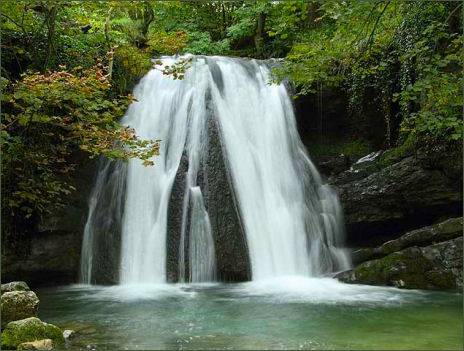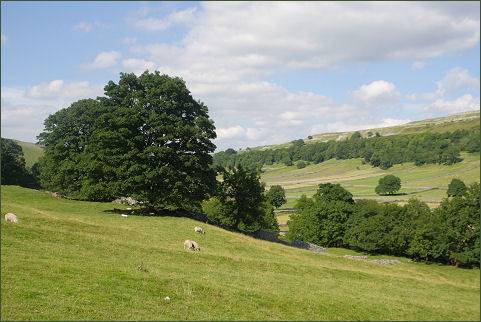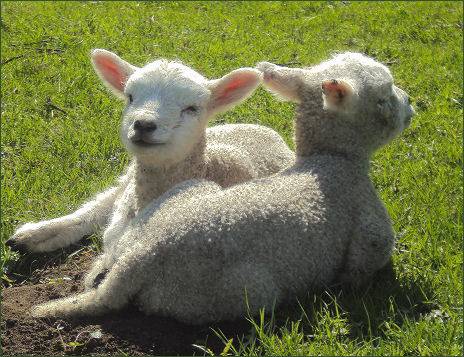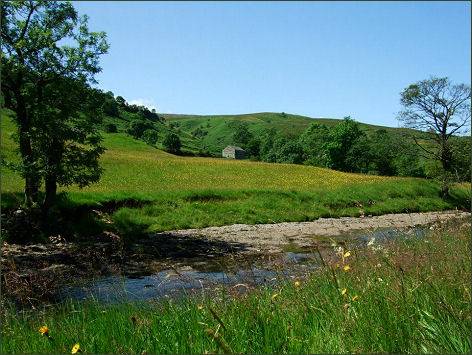Yorkshire Dales National Park
 The Yorkshire Dales National Park encompasses an area of 1,770 square kilometres (680 square miles). which boasts spectacular limestone scenry. The area was designated a National Park in 1954.
The Yorkshire Dales National Park encompasses an area of 1,770 square kilometres (680 square miles). which boasts spectacular limestone scenry. The area was designated a National Park in 1954.
The national park does not include all of the Yorkshire Dales. Parts of the dales to the south and east of the national park form the Nidderdale Area of Outstanding Natural Beauty.
Some of the highlights of the Yorkshire Dales National Park include spectacular Aysgarth Falls, which consists of a triple flight of waterfalls in a wooded gorge of the River Ure near the village of Aysgarth. Although not particularly high the waterfalls are one of Wensleydale's most famous beauty spots.
Imposing Malham Cove, one of the natural wonders of Yorkshire is a natural limestone formation which stands around a kilometre to the north of the village of Malham. A large, curved ampitheatre shaped limestone cliff formation rises to 80 metres (260 feet) and looms over the head of a valley. On the west side of the cliff face are irregular stone steps which form part of the route of the Pennine Way and lead to an uneven limestone pavement at the top.
 Malham Tarn is a glacial lake, at 377 metres (1,237 feet) above sea level, it is the highest lake in England. The tarn forms part of a Nature Reserve, situated between Wharfedale and Ribblesdale and is home to a number of rare species, some of which are remnants from the last Ice Age. The Malham Tarn Estate contains some of the most dramatic upland limestone landscape in the country.
Malham Tarn is a glacial lake, at 377 metres (1,237 feet) above sea level, it is the highest lake in England. The tarn forms part of a Nature Reserve, situated between Wharfedale and Ribblesdale and is home to a number of rare species, some of which are remnants from the last Ice Age. The Malham Tarn Estate contains some of the most dramatic upland limestone landscape in the country.
Dramatic Gordale Scar is a limestone ravine located around 1 mile northeast of of the village of Malham. The area around Gordale and nearby Malham Cove is the most visited area in the entire national park. The ravine contains two waterfalls and has overhanging limestone cliffs which soar to over 100 metres high.
Gordale Beck tumbles over waterfalls through gorge then flows on to the Janet's Foss waterfall before joining Malham Beck two miles downstream to form the River Aire. Limestone and Tufa are features of the Scar. Tufa forms on the limestone rocks and is caused by calcium carbonate rich water precipitation.
Janet's Foss (pictured above left), close to Gordale Scar is situated near to the village of Malham. The waterfall on Gordale Beck falls over a limestone outcrop into a deep pool below. Magnificent Hardraw Force is situated in Hardraw Scar, a scenic wooded ravine at the head of the beautiful North Yorkshire valley of Wensleydale. The waterfall consists of a single drop of 100 feet and is said to be the highest unbroken waterfall in England.
 White Scar Cave, located a mile and a half from Ingleton, is the
longest show cave in Britain.
The cave was discovered in 1923, by Christopher Long, a student at Cambridge, while on holiday in the Yorkshire Dales, he came upon
a hole in the hillside that seemed to go on for ever. Further parts of the system were opened up in 1991 by an access tunnel. The cave contains underground waterfalls and streams, and thousands of stalactites.
White Scar Cave, located a mile and a half from Ingleton, is the
longest show cave in Britain.
The cave was discovered in 1923, by Christopher Long, a student at Cambridge, while on holiday in the Yorkshire Dales, he came upon
a hole in the hillside that seemed to go on for ever. Further parts of the system were opened up in 1991 by an access tunnel. The cave contains underground waterfalls and streams, and thousands of stalactites.
The famous Ingleton Waterfalls which opened in 1885, is 8 kilometres (5 miles) long with a rise of 169 metres (554 feet) has some of the most spectacular waterfall and woodland scenery in the north of England. It passes through ancient oak woodland and magnificent scenery via a series of stunning waterfalls and geological features.
Stainforth Force, just to the west of Stainforth village near Settle, is a highly attractive spot. The River Ribble tumbles over a series of limestone ledges into a deep, broad pool. Salmon can often be sighted leaping on their final journey up river to their spawning grounds. Above the waterfall an old Pack Horse Bridge crosses the River Ribble. Nearby Catrigg Force, situated about 4 miles away is also very picturesque.
Forbidden Corner is a folly-filled garden in the grounds of the Tupgill Park Estate near Leyburn. The acclaimed garden features on the Huffington Post "Top 10 Pieces of Folly Architecture and consists of a number of follies, woodlands, walled gardens, tunnels and grottoes furnished with statues, installations and other works of art, architecture, animated models and various oddities largely drawn from the European classical tradition which are arranged to create a maze for the visitor to explore.
Bolton Castle dates to the fourteenth century and is situated near Wensleydale. The quadrangular castle was built between 1378 and 1399 by Richard, 1st Baron Scrope of Bolton, Lord Treasurer and Lord Chancellor to King Richard II. Scrope spared little expense in the construction of his new stronghold, from 1379 until the building was completed around 1399 he spent some 18,000 marks on the structure.
The tragic Mary, Queen of Scots stayed at Bolton for six months in 1568, following her defeat by the Scottsh Protestant lords at the Battle of Langside in 1568, Mary fled to England, to evoke aid from her cousin Queen Elizabeth I. The Queen of Scots was lodged in Henry Scrope's own apartments in the South-West tower.
The Bolton Abbey estate in Wharfedale, to the east of Skipton, is well worth seeing. The estate acquires its name from Bolton Priory, the twelfth century ruins of an Augustinian monastery. The estate is situated within a highly attractive landscape, adjacent to the village of Bolton Abbey, the estate consists of just under 30,000 acres of beautiful countryside and has over 80 miles of footpaths.
In addition there are many attractive villages and towns within the National Park borders, including the market town of Grassington, one of the most popular tourist destinations in the Yorkshire Dales, the picturesque market town of Hawes, set amidst the stunning scenery of Wensleydale is one of the tourist magnets of the Yorkshire Dales. The picturesque village of Hubberholme, in Upper Wharfedale, the picture postcard village of Linton and the highly attractive riverside village of Burnsall in Upper Wharfedale.
 Starbotton, in stunning Upper Wharfedale, is a small, pretty village of much character.
Picturesquely situated on the banks of the River Wharfe, Starbotton consists of around 70 houses, the majority of which are used as holiday accommodation, and two working farms, one at either end of the village.
Starbotton, in stunning Upper Wharfedale, is a small, pretty village of much character.
Picturesquely situated on the banks of the River Wharfe, Starbotton consists of around 70 houses, the majority of which are used as holiday accommodation, and two working farms, one at either end of the village.
Bainbridge, a further attractive Yorkshire Dales village, is situated in beautiful Wensleydale, near the confluence of the rivers Bain and Ure. The village's only pub, the Rose and Crown, is reputed to be one of Yorkshire's oldest inn, having been in operation since 1445. . The picturesque village of Clapham in the Craven district of North Yorkshire, lies 6 miles (10 km) to the north-west of Settle and at the base of Ingleborough, one of Yorkshire's 'Three Peaks'.
The linear village of Askrigg lies at the heart of the Yorkshire Dales, in beautiful Upper Wensleydale, the village is famous for its association with fictional vet James Herriot, and played the part of Darrowby in the BBC television series 'All Creatures Great and Small'.
The bustling market town of Settle is situated in the Craven district of North Yorkshire, one of the most scenic areas of the Yorkshire Dales. The town is famous as the starting point of the Settle-Carlisle Railway. The area around Settle has several caves where prehistoric remains have been discovered, the most famous being Victoria Cave, so named as the inner chamber was discovered in 1837 on the day of Queen Victoria's accession to the throne. The cave, which was discovered by chance, was found to contain remains of mammoth, bear, reindeer and hippopotamus and flint implements. In amongst the bones of reindeer was an year old antler harpoon point, the first evidence for human habitation in the Yorkshire Dales.
The Dales Countryside Museum is housed in a converted railway station at Hawes in Wensleydale
